+ Open data
Open data
- Basic information
Basic information
| Entry | Database: PDB / ID: 1q38 | ||||||
|---|---|---|---|---|---|---|---|
| Title | Anastellin | ||||||
 Components Components | Fibronectin | ||||||
 Keywords Keywords | CELL ADHESION / amyloid fibril / anastellin / extracellular matrix / fibronectin type 3 (FN3) domain / dynamic fluctuations / conformational exchange / CHAPS | ||||||
| Function / homology |  Function and homology information Function and homology informationnegative regulation of monocyte activation / negative regulation of transforming growth factor beta production / Extracellular matrix organization / positive regulation of substrate-dependent cell migration, cell attachment to substrate / calcium-independent cell-matrix adhesion / Fibronectin matrix formation / neural crest cell migration involved in autonomic nervous system development / fibrinogen complex / peptide cross-linking / integrin activation ...negative regulation of monocyte activation / negative regulation of transforming growth factor beta production / Extracellular matrix organization / positive regulation of substrate-dependent cell migration, cell attachment to substrate / calcium-independent cell-matrix adhesion / Fibronectin matrix formation / neural crest cell migration involved in autonomic nervous system development / fibrinogen complex / peptide cross-linking / integrin activation / ALK mutants bind TKIs / cell-substrate junction assembly / proteoglycan binding / extracellular matrix structural constituent / MET activates PTK2 signaling / Molecules associated with elastic fibres / peptidase activator activity / biological process involved in interaction with symbiont / Syndecan interactions / p130Cas linkage to MAPK signaling for integrins / response to muscle activity / endoplasmic reticulum-Golgi intermediate compartment / endodermal cell differentiation / regulation of protein phosphorylation / GRB2:SOS provides linkage to MAPK signaling for Integrins / basement membrane / Non-integrin membrane-ECM interactions / ECM proteoglycans / Integrin cell surface interactions / endothelial cell migration / regulation of ERK1 and ERK2 cascade / positive regulation of axon extension / collagen binding / Degradation of the extracellular matrix / Integrin signaling / extracellular matrix / substrate adhesion-dependent cell spreading / platelet alpha granule lumen / Turbulent (oscillatory, disturbed) flow shear stress activates signaling by PIEZO1 and integrins in endothelial cells / cell-matrix adhesion / acute-phase response / integrin-mediated signaling pathway / Cell surface interactions at the vascular wall / Post-translational protein phosphorylation / wound healing / Signaling by high-kinase activity BRAF mutants / MAP2K and MAPK activation / response to wounding / integrin binding / Regulation of Insulin-like Growth Factor (IGF) transport and uptake by Insulin-like Growth Factor Binding Proteins (IGFBPs) / positive regulation of fibroblast proliferation / Signaling by RAF1 mutants / Signaling by moderate kinase activity BRAF mutants / Paradoxical activation of RAF signaling by kinase inactive BRAF / Signaling downstream of RAS mutants / Signaling by ALK fusions and activated point mutants / Signaling by BRAF and RAF1 fusions / Platelet degranulation / GPER1 signaling / nervous system development / regulation of cell shape / heparin binding / : / heart development / protease binding / angiogenesis / Interleukin-4 and Interleukin-13 signaling / blood microparticle / positive regulation of phosphatidylinositol 3-kinase/protein kinase B signal transduction / cell adhesion / apical plasma membrane / receptor ligand activity / endoplasmic reticulum lumen / signaling receptor binding / positive regulation of cell population proliferation / positive regulation of gene expression / extracellular space / extracellular exosome / extracellular region / identical protein binding / plasma membrane Similarity search - Function | ||||||
| Biological species |  Homo sapiens (human) Homo sapiens (human) | ||||||
| Method | SOLUTION NMR / Aria protocol | ||||||
 Authors Authors | Briknarova, K. / Akerman, M.E. / Hoyt, D.W. / Ruoslahti, E. / Ely, K.R. | ||||||
 Citation Citation |  Journal: J.Mol.Biol. / Year: 2003 Journal: J.Mol.Biol. / Year: 2003Title: Anastellin, an FN3 fragment with fibronectin polymerization activity, resembles amyloid fibril precursors Authors: Briknarova, K. / Akerman, M.E. / Hoyt, D.W. / Ruoslahti, E. / Ely, K.R. #1:  Journal: Nature / Year: 1994 Journal: Nature / Year: 1994Title: Superfibronectin is a functionally distinct form of fibronectin Authors: Morla, A. / Zhang, Z. / Ruoslahti, E. #2:  Journal: NAT.MED. (N.Y.) / Year: 1996 Journal: NAT.MED. (N.Y.) / Year: 1996Title: A polymeric form of fibronectin has antimetastatic effects against multiple tumor types Authors: Pasqualini, R. / Bourdoulous, S. / Koivunen, E. / Woods Jr., V.L. / Ruoslahti, E. #3:  Journal: Proc.Natl.Acad.Sci.USA / Year: 2001 Journal: Proc.Natl.Acad.Sci.USA / Year: 2001Title: A fibronectin fragment inhibits tumor growth, angiogenesis, and metastasis Authors: Yi, M. / Ruoslahti, E. | ||||||
| History |
|
- Structure visualization
Structure visualization
| Structure viewer | Molecule:  Molmil Molmil Jmol/JSmol Jmol/JSmol |
|---|
- Downloads & links
Downloads & links
- Download
Download
| PDBx/mmCIF format |  1q38.cif.gz 1q38.cif.gz | 958.5 KB | Display |  PDBx/mmCIF format PDBx/mmCIF format |
|---|---|---|---|---|
| PDB format |  pdb1q38.ent.gz pdb1q38.ent.gz | 808.6 KB | Display |  PDB format PDB format |
| PDBx/mmJSON format |  1q38.json.gz 1q38.json.gz | Tree view |  PDBx/mmJSON format PDBx/mmJSON format | |
| Others |  Other downloads Other downloads |
-Validation report
| Summary document |  1q38_validation.pdf.gz 1q38_validation.pdf.gz | 343.6 KB | Display |  wwPDB validaton report wwPDB validaton report |
|---|---|---|---|---|
| Full document |  1q38_full_validation.pdf.gz 1q38_full_validation.pdf.gz | 622.6 KB | Display | |
| Data in XML |  1q38_validation.xml.gz 1q38_validation.xml.gz | 53.7 KB | Display | |
| Data in CIF |  1q38_validation.cif.gz 1q38_validation.cif.gz | 86.1 KB | Display | |
| Arichive directory |  https://data.pdbj.org/pub/pdb/validation_reports/q3/1q38 https://data.pdbj.org/pub/pdb/validation_reports/q3/1q38 ftp://data.pdbj.org/pub/pdb/validation_reports/q3/1q38 ftp://data.pdbj.org/pub/pdb/validation_reports/q3/1q38 | HTTPS FTP |
-Related structure data
| Related structure data | |
|---|---|
| Similar structure data |
- Links
Links
- Assembly
Assembly
| Deposited unit | 
| |||||||||
|---|---|---|---|---|---|---|---|---|---|---|
| 1 |
| |||||||||
| NMR ensembles |
|
- Components
Components
| #1: Protein | Mass: 10175.405 Da / Num. of mol.: 1 / Fragment: Type 3 (FN3) domain Source method: isolated from a genetically manipulated source Source: (gene. exp.)  Homo sapiens (human) / Gene: FN1 OR FN / Production host: Homo sapiens (human) / Gene: FN1 OR FN / Production host:  |
|---|
-Experimental details
-Experiment
| Experiment | Method: SOLUTION NMR | ||||||||||||
|---|---|---|---|---|---|---|---|---|---|---|---|---|---|
| NMR experiment |
|
- Sample preparation
Sample preparation
| Details |
| |||||||||
|---|---|---|---|---|---|---|---|---|---|---|
| Sample conditions | Ionic strength: 150 / pH: 7 / Pressure: ambient / Temperature: 298 K | |||||||||
| Crystal grow | *PLUS Method: other / Details: NMR |
-NMR measurement
| Radiation | Protocol: SINGLE WAVELENGTH / Monochromatic (M) / Laue (L): M | |||||||||||||||
|---|---|---|---|---|---|---|---|---|---|---|---|---|---|---|---|---|
| Radiation wavelength | Relative weight: 1 | |||||||||||||||
| NMR spectrometer |
|
- Processing
Processing
| NMR software |
| ||||||||||||||||||||
|---|---|---|---|---|---|---|---|---|---|---|---|---|---|---|---|---|---|---|---|---|---|
| Refinement | Method: Aria protocol / Software ordinal: 1 / Details: multiple Aria runs | ||||||||||||||||||||
| NMR representative | Selection criteria: closest to the average | ||||||||||||||||||||
| NMR ensemble | Conformer selection criteria: structures with the lowest energy Conformers calculated total number: 100 / Conformers submitted total number: 35 |
 Movie
Movie Controller
Controller




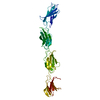



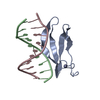
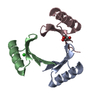

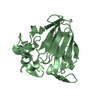
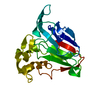
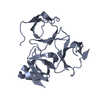

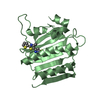
 PDBj
PDBj
















